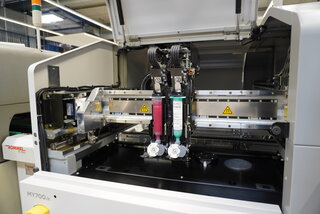IPC standards - The basis for quality in electronics production
“A common language in electronics production - that's what IPC standards create.”
As an EMS service provider, we support our customers from the initial idea to the finished product - and place great value on reproducible quality. The IPC standards form our central set of rules. They ensure that development, production, quality assurance and customers communicate on a common basis - technically sound and internationally coordinated.
The IPC (International Printed Circuit Association) is a global association of 29 member countries. It develops practical, production-related standards for the entire electronics industry - and has been doing so for decades. The standards are regarded worldwide as a reference for quality and reliability in electronics production.
Where in the production process do IPC standards actually apply?
IPC standards accompany every phase of a project. In our daily work, we see how important these standards are for smooth and comprehensible cooperation with customers and partners:
Even at the layout stage, deviations from the standard can cause subsequent errors.
Practical example: Inadequate pad geometries or non-IPC-compliant spacing lead to soldering problems - and therefore to rework or rejects.
- This is where the first design guidelines according to IPC-2221/2222 come into play.
Tip: Use our production guide - it translates IPC specifications into practical recommendations for your design team.
As soon as components are on the PCB, the specifications of IPC-A-610 apply. It describes exactly what an acceptable soldering pattern looks like, which distances must be maintained and how assemblies are visually assessed.
- Our visual inspectors are trained in accordance with IPC-A610 in order to assess even borderline cases in line with the standard.
Why are IPC standards decisive for quality?
IPC standards create a clear, internationally recognized basis for the evaluation and manufacture of electronic assemblies - they ensure quality, promote understanding between all parties involved and minimize risks in production.
Advantages at a glance:
- Standardized evaluation basis - internally and externally
- Systematize defect detection instead of working on instinct
- Clear communication between development, production, quality and customer
- Avoidance of misunderstandings, e.g. during acceptance or complaints
- Global comparability through recognized standards
| IPC-Classes | Application examples | Requirements |
| Class 1 | Consumer goods, simple household appliances, toys | Simple functionality, basic requirements - devices must work, but be easy to replace. |
| Class 2 | Communication devices, consumer electronics | Durable, reliable, stable - products should function permanently and without interruption. |
| Class 3 | Medical technology, aviation, safety-relevant automotive applications | Maximum reliability, maximum fail-safety - functionality must be guaranteed at all times. |
Why is a certified IPC trainer so important?
Technical expertise and standard-compliant work are the basis for high-quality electronics production. That's why we rely on a certified IPC trainer in-house. He is officially certified by the association and authorized to train the IPC-A610 content internally.
Our quality-relevant employees in production are trained in accordance with IPC-A-610 - and this is mandatory every two years. In this way, we ensure that everyone involved has a common, up-to-date understanding of the applicable standards from the initial consultation to the finished assembly - precise, practical and customer-oriented.
Your advantage as a customer:
- Up-to-date knowledge of standards: All quality-relevant employees are trained and certified every two years.
- Sound advice: Standards-compliant support from the very first project phase.
- High process reliability: Reliable quality thanks to in-depth understanding of the specifications.
Our claim: IPC standards are not just theory for us, but a living standard. This enables us to ensure the quality of your products, optimize workflows and ensure transparent, efficient processes.
How do we ensure IPC-compliant quality?
Our quality concept is based on several levels - each of which is geared to the applicable IPC specifications:
- Incoming goods inspection incl. visual inspection in accordance with IPC-A-600
- AOI systems - automatic optical inspection of assemblies
- Microscopic spot checks in accordance with IPC-A-610
- Internal audits for continuous compliance with standards
What can you do to develop IPC-compliant products?
Many challenges in electronics production do not just arise during production - they start in the design phase. Unfavorable pad geometries, components that are difficult to access or a lack of free space lead to rework, rejects or unnecessary additional costs later on.
We know from experience: Paying attention to production-oriented design at an early stage saves time, costs and noticeably improves quality later on.
That's why we recommend it: Plan right from the start with our EMS manufacturing guide.
The guide is aimed at developers, layout designers and technical purchasers and offers practical support for optimally adapting your assemblies to our production processes and the requirements of the IPC standards.
Your benefits at a glance:
- Better initial yield - because typical design errors are avoided
- Shorter time-to-market - thanks to fewer queries and correction loops
- Less rework - clearer processes, less effort
- Clearly defined acceptance criteria - right from the first sample





